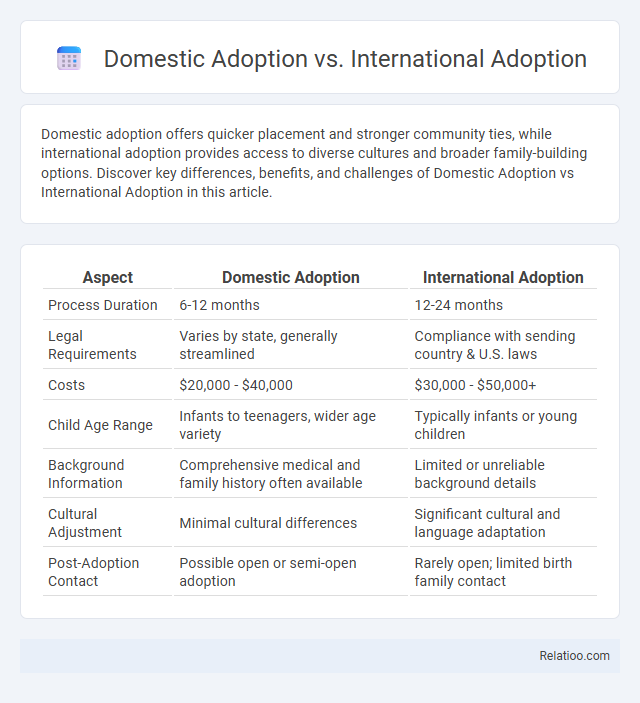Domestic adoption offers quicker placement and stronger community ties, while international adoption provides access to diverse cultures and broader family-building options. Discover key differences, benefits, and challenges of Domestic Adoption vs International Adoption in this article.
Table of Comparison
| Aspect | Domestic Adoption | International Adoption |
|---|---|---|
| Process Duration | 6-12 months | 12-24 months |
| Legal Requirements | Varies by state, generally streamlined | Compliance with sending country & U.S. laws |
| Costs | $20,000 - $40,000 | $30,000 - $50,000+ |
| Child Age Range | Infants to teenagers, wider age variety | Typically infants or young children |
| Background Information | Comprehensive medical and family history often available | Limited or unreliable background details |
| Cultural Adjustment | Minimal cultural differences | Significant cultural and language adaptation |
| Post-Adoption Contact | Possible open or semi-open adoption | Rarely open; limited birth family contact |
Understanding Domestic and International Adoption
Understanding domestic and international adoption involves recognizing the key differences in legal processes, cultural considerations, and timeframes. Domestic adoption typically offers faster placement within your own country and fewer regulatory hurdles, while international adoption requires navigating complex immigration laws and cross-cultural adjustments. Your choice depends on factors such as eligibility requirements, adoption costs, and the desire for a specific cultural connection in the child's upbringing.
Key Differences Between Domestic and International Adoption
Domestic adoption involves placing a child within the adoptive parents' own country, often resulting in shorter waiting periods and lower costs compared to international adoption. International adoption requires navigating complex immigration laws, additional paperwork, and potentially longer timelines due to intercountry regulations and travel. Both processes demand thorough home studies and background checks, but international adoption may involve cultural and legal challenges unique to the child's country of origin.
Eligibility Requirements for Adoptive Parents
Eligibility requirements for domestic adoption typically include age limits, stable income, good health, and background checks, which vary by state but generally focus on your ability to provide a safe home. International adoption often imposes stricter criteria, such as specific age ranges, marital status, and sometimes religious affiliation, alongside extensive home studies and compliance with both U.S. and foreign country regulations. Adoption eligibility universally prioritizes parental stability, legal capacity, and thorough screening to ensure the child's best interests are met.
Adoption Process and Timeline Comparison
Domestic adoption typically involves shorter timelines ranging from 6 to 12 months due to established legal frameworks and local agency support, while international adoption can extend from 1 to 3 years depending on the country's regulations, visa processes, and diplomatic relations. The adoption process for domestic cases often includes home studies, background checks, and matching within state or regional agencies, whereas international adoption requires additional steps such as compliance with The Hague Adoption Convention, immigration paperwork, and coordination with foreign governments. Both adoption types necessitate comprehensive legal approval and post-placement supervision, but international adoption generally demands more extensive documentation and travel commitments.
Legal Considerations in Adoption
Legal considerations in adoption vary significantly between domestic adoption, international adoption, and general adoption processes, each governed by distinct laws and regulations to protect the rights of birth parents, adoptive parents, and children. Domestic adoption typically involves adherence to state laws, requiring home studies, background checks, and court approvals to ensure the best interests of the child, while international adoption must comply with both the sending country's laws and international treaties such as the Hague Adoption Convention, adding complexity to the legal process. Understanding these differences is crucial for you to navigate the legal requirements, timelines, and eligibility criteria effectively, ensuring a smooth and lawful adoption journey.
Costs Involved in Domestic vs International Adoption
Domestic adoption typically incurs costs ranging from $20,000 to $40,000, covering agency fees, legal expenses, and home studies, with variations depending on whether the adoption is private or through foster care. International adoption costs often exceed $30,000 to $50,000 due to additional expenses such as travel, immigration processing, and foreign agency fees. Financial assistance or subsidy options may be more accessible in domestic adoption through public foster care programs, whereas international adoption expenses are generally less subsidized and require more upfront financial commitment.
Cultural and Racial Identity Issues
Domestic adoption often allows children to maintain closer ties to their cultural and racial heritage, supporting a smoother identity development within familiar environments. International adoption may present challenges related to cultural dissonance and racial identity, requiring adoptive parents to actively engage in cultural education and community connections. Your approach to adoption should prioritize understanding and embracing the child's cultural and racial background to promote healthy identity formation.
Travel and Post-Adoption Requirements
Domestic adoption generally involves less travel and simpler post-adoption requirements, typically limited to home visits and local legal finalization. International adoption requires extensive travel to the child's country, adherence to both countries' legal processes, and often longer post-adoption monitoring periods by foreign authorities. Adoption, in general, demands compliance with legal stipulations, but international adoption imposes more complex travel logistics and stringent post-adoption reports due to international regulations and child protection standards.
Support Services and Resources for Adoptive Families
Domestic adoption often provides localized support services such as counseling, legal guidance, and post-adoption resources tailored to state regulations. International adoption requires additional resources including cultural orientation, immigration assistance, and access to bilingual support networks to help your family navigate complex cross-border processes. Adoption agencies and nonprofit organizations offer ongoing education, support groups, and mental health services to ensure adoptive families receive comprehensive care throughout their journey.
Choosing the Right Adoption Path for Your Family
Choosing the right adoption path for your family involves evaluating factors such as legal requirements, waiting times, and cultural considerations. Domestic adoption often provides quicker placement and easier access to support networks, whereas international adoption requires navigating complex immigration laws and cultural adjustments. Understanding your family's needs and resources helps determine whether domestic, international, or alternative adoption options best align with your goals.

Infographic: Domestic Adoption vs International Adoption
 relatioo.com
relatioo.com